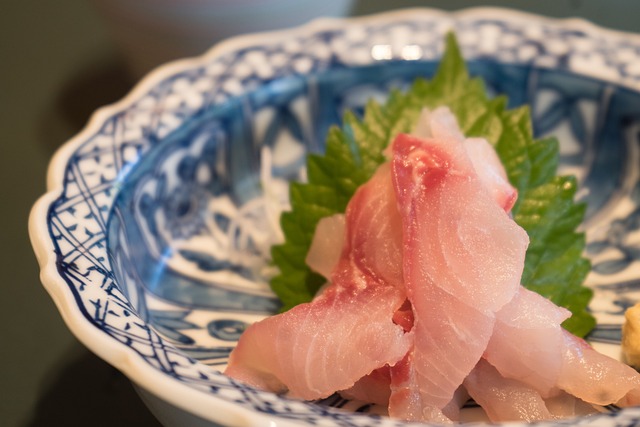
Nestled within the heart of Japanese culture lies the art of raw foods, a delicate and refined gastronomic practice that has captivated epicures around the globe. From the elegant silkiness of sushi to the pristine simplicity of sashimi, Japan has bestowed upon the world a culinary legacy that celebrates the true essence of freshness and authenticity.
Sushi, the crown jewel of Japanese cuisine, holds a revered position within the raw food realm. Its symphony of flavors, textures, and colors gives rise to an experience that transcends the ordinary. The austere simplicity of each morsel invites one to embark on an epicurean exploration, a unique journey that celebrates the purity of flavor and the artistry of presentation.
In the parallel realm of sashimi, the focus shifts towards unparalleled refinement and the untamed allure of raw seafood. Echoing the Zen philosophy of minimalism, sashimi celebrates the essence of the ocean’s bounty in its most unadulterated form.
To truly appreciate the cultural significance and artistry of Japanese raw foods, one must delve beyond the mere act of consumption. At the heart of this culinary tradition lies a deep-rooted respect for sustainability, seasonality, and meticulous craftsmanship.
Understanding Sushi
The world of sushi is a captivating one, steeped in tradition, precision, and a deep appreciation for the nuances of flavor and texture. To truly understand and appreciate sushi, one must embark on a journey that explores its history, its various forms, and the techniques employed by sushi chefs. Allow yourself to be transported into the realm of this culinary art as we delve into the intricacies of sushi.
Sushi, in its earliest form, can be traced back to ancient Southeast Asia, where it was used as a preservation technique for fish. The fish would be salted and fermented, then packed in rice to aid in the preservation process. Over time, this preservation method evolved, and rice began to be consumed along with the fish, giving rise to the sushi we know today. It was in Japan where sushi truly flourished, taking on various regional styles and becoming an integral part of Japanese culture.
Types of Sushi
Nigiri: Perhaps the most recognizable form of sushi, nigiri consists of a small mound of vinegared rice topped with a slice of fresh seafood. The simplicity of this style allows the natural flavors of the ingredients to shine through. Common toppings include tuna, salmon, yellowtail, and shrimp.
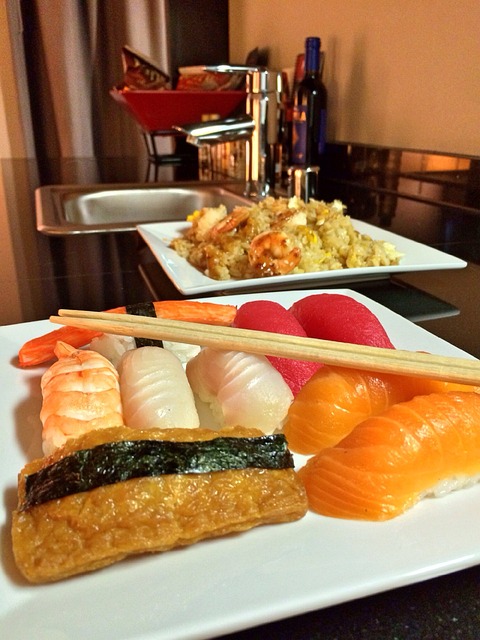
Maki: Maki sushi is characterized by its cylindrical shape, created by rolling a sheet of seaweed (nori) and rice around a filling, which could be fish, vegetables, or even tempura. Maki rolls are then sliced into bite-sized pieces, showcasing a beautiful cross-section of flavors and colors.
Temaki: Temaki, also known as hand rolls, are individually wrapped cones of nori filled with rice, seafood, and vegetables. These portable and customizable treats are often enjoyed on the go or as a casual dining experience.
Sashimi and Sushi: Unraveling the Differences
While sashimi and sushi may seem similar on the surface, they are distinct culinary experiences. Sashimi refers specifically to thin slices of raw fish or seafood, served without rice. This allows the focus to be solely on the quality and freshness of the seafood, providing a pure and unadulterated taste. Sushi, on the other hand, combines the art of combining vinegared rice with various ingredients, including sashimi, to create a harmonious balance of flavors and textures.
A Closer Look at Sashimi
Sashimi, a masterpiece of simplicity and elegance, offers a tantalizing exploration of the ocean’s bounty in its purest form. This pristine dish showcases the delicate flavors and textures of raw fish or seafood, providing a sensory experience that transcends the ordinary. Let us delve deeper into the enchanting realm of sashimi, uncovering its traditions, presentation styles, and the exceptional quality that sets it apart.
Deeply rooted in Japanese culture, sashimi represents the epitome of culinary excellence. The preparation of sashimi involves the utmost precision and skill, as it requires a keen eye for selecting the freshest ingredients and the dexterity to slice them with absolute finesse. Traditional slicing techniques, such as the hira-zukuri (rectangular slice) or the usuzukuri (thinly sliced), are employed to enhance the texture and appearance of the sashimi.
Presentation is Key
The art of sashimi extends beyond the mere act of slicing raw fish. It is a carefully choreographed symphony of flavors, textures, and visual aesthetics that comes together on the plate. The presentation of sashimi is often accompanied by an assortment of delicate garnishes, artfully arranged to complement and elevate the experience. From the vibrant hues of edible flowers to the subtle elegance of thinly sliced radishes or daikon, every element is meticulously chosen to create a feast for the eyes as well as the palate.
A Dive into Variety
Sashimi offers a vast array of possibilities, showcasing the breadth and diversity of flavors that the ocean offers. A few popular fish options for sashimi include maguro (tuna), salmon, hamachi (yellowtail), and tako (octopus). Each fish possesses its own unique texture, taste, and nuance, allowing for a symphony of flavors to be explored.
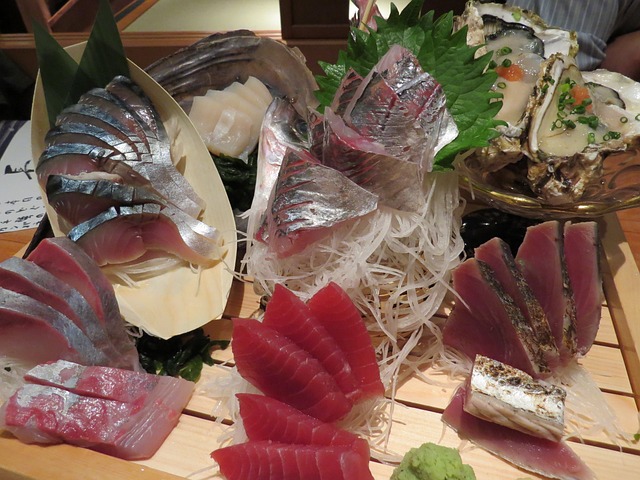
Beyond the seafood realm, sashimi can also include delicacies such as uni (sea urchin), ikura (salmon roe), or even wagyu beef. These exquisite choices provide an opportunity to experience the rich tapestry of flavors that sashimi encompasses.
Enhancing the Experience
To fully appreciate the purity of sashimi, it is often enjoyed with a variety of accompaniments that enhance its flavors. Wasabi, a spicy green condiment, is frequently offered to add a gentle kick to each bite. Shoyu, or soy sauce, provides a savory element that complements the natural flavors of the fish. And for those seeking a touch of acidity, a squeeze of fresh citrus, such as yuzu or lemon, can add a delightful zest.
Sashimi Etiquette
Savoring sashimi is an experience steeped in tradition and etiquette. To fully embrace the cultural significance of this delicacy, it is important to observe a few customs. Using chopsticks or small serving plates, it is customary to pick up a single slice of sashimi, dip it gently into soy sauce, and enjoy it in one bite. This allows for a harmonious balance of flavors and ensures that the sashimi is consumed at its freshest.
Traditional Sushi Etiquette
Sushi is not just a meal; it is a sacred art form that demands respect and reverence. To fully immerse yourself in the authentic sushi experience, it is essential to observe the traditions and etiquette that have been passed down through generations. By adhering to these time-honored customs, you will not only show appreciation for the culinary craftsmanship but also enhance your own enjoyment of this exquisite cuisine.
Sushi Bar Etiquette:
When dining at a traditional sushi bar, it is customary to sit at the counter rather than a table. This allows for a more immersive experience, as you have a direct view of the sushi chef and can witness their skillful preparation. If there are empty seats at the counter, it is considered polite to ask for permission before taking a seat next to other customers.
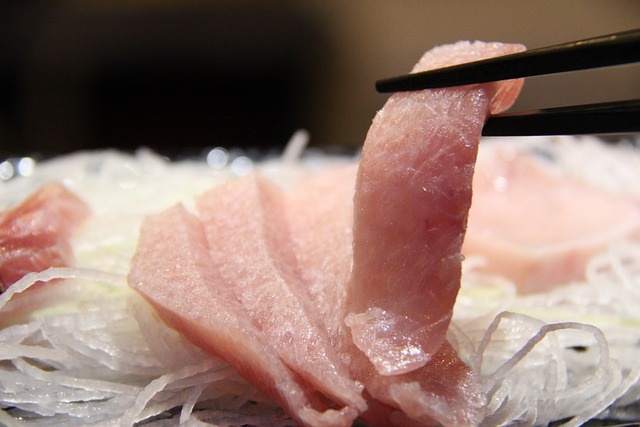
Greeting the Sushi Chef:
The sushi chef, known as the Itamae, is the master behind this culinary art. As a sign of respect, it is customary to greet the Itamae with a simple “Omakase” or “Osakini” upon arrival. These phrases essentially mean “I leave it up to you” and show that you trust the chef’s expertise in selecting the best sushi for you.
Nigiri Sushi Etiquette:
Nigiri sushi is the pinnacle of sushi simplicity, with a small mound of vinegared rice topped with a slice of fresh seafood. When eating nigiri sushi, it is customary to pick it up with your hands rather than using chopsticks. This showcases a connection between the diner and the sushi, allowing for a more intimate experience. Dip the nigiri lightly into soy sauce, fish-side down, to ensure that the rice does not become overly saturated.
Wasabi Placement:
Traditionally, the sushi chef will already include a small amount of wasabi between the rice and the fish. However, if you desire a bit more heat, it is considered acceptable to add a touch of wasabi to your soy sauce. Mix the wasabi into the soy sauce gently, creating a dipping sauce for your sushi. Avoid applying wasabi directly onto the sushi as it may overpower the delicate flavors.
Savor Each Piece:
Sushi is meant to be enjoyed slowly, with each piece savored and appreciated. Take the time to fully experience the flavors and textures of each sushi creation before moving on to the next one. Engage all your senses as you admire the presentation, inhale the subtle aromas, and relish the explosion of flavors in your mouth.
Respectful Consumption:
When eating sushi, it is proper to consume the entire piece in one bite. This allows for a harmonious combination of flavors as the rice, fish, and any accompanying ingredients meld together on the palate. Avoid biting or separating the sushi into smaller pieces, as this disrupts the balance that the Itamae has carefully crafted.
Drinking Sake:
Sake, the traditional Japanese rice wine, is often enjoyed alongside sushi. If you choose to indulge in this cultural beverage, it is polite to wait until the sushi chef has presented your first piece of sushi before taking your first sip. This shows respect for the timing and presentation of the meal.
Expressing Gratitude:
At the end of your meal, it is customary to express gratitude to the sushi chef for their culinary artistry. A simple “Gochisousama deshita” translates to “Thank you for the meal” and acknowledges the chef’s dedication and effort in creating an exceptional dining experience.
By following these traditional sushi etiquette practices, you not only pay homage to the centuries-old traditions but also engage in a profound connection with the culture that birthed this extraordinary culinary art. Treat each sushi encounter as a sacred ritual, and let the enchanting flavors transport you to the exquisite world of Japanese gastronomy.
Health and Safety Considerations
When indulging in the delectable world of raw foods, it is crucial to prioritize health and safety to ensure a joyful and worry-free culinary experience. Here are some essential considerations to keep in mind:
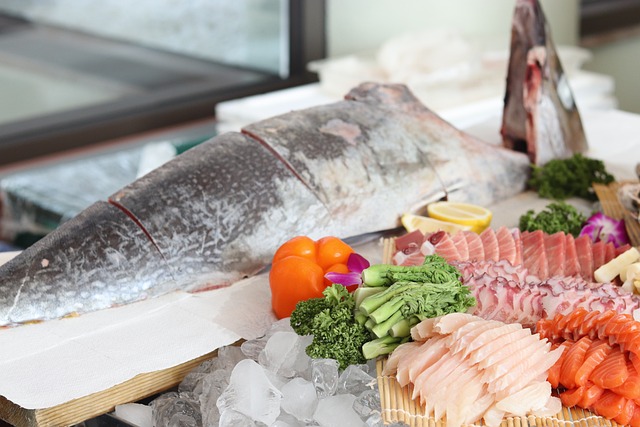
Freshness is Key: The cornerstone of raw food preparation is the quality and freshness of the ingredients. Only select the highest quality seafood from trusted fishmongers or reputable sources. Look for signs of freshness such as clear eyes, vibrant colors, and a distinct oceanic aroma.
Proper Storage: Raw seafood is highly perishable and requires careful storage to maintain its freshness and minimize the risk of foodborne illness. Store seafood in a refrigerator set to temperatures below 40°F (4°C). Keep different types of seafood separate and properly sealed to prevent cross-contamination.
Hygiene and Cleanliness: Cleanliness is paramount when handling raw seafood. Wash your hands thoroughly before and after handling raw fish or seafood. Ensure that all utensils, cutting boards, and surfaces used for raw food preparation are clean and sanitized. Avoid using the same utensils for raw and cooked foods to prevent cross-contamination.
Parasite Prevention: Some fish, such as salmon and trout, may potentially contain parasites. To minimize the risk of parasitic infection, freeze the fish at temperatures below -4°F (-20°C) for at least seven days or cook it to an internal temperature of 145°F (63°C) for 15 seconds.
Allergies and Dietary Restrictions: If you have allergies or dietary restrictions, it is important to inform your sushi chef or server beforehand. They can guide you in selecting appropriate options that meet your needs and avoid potential allergens.
Wasabi and Soy Sauce: Wasabi and soy sauce are common accompaniments to raw foods, but it is advisable to use them sparingly. Be cautious with the amount of wasabi you add to your soy sauce, as it can overpower the delicate flavors of the raw fish. Moderation is key.
Sushi Rice: The vinegared rice used in sushi is an essential component of the dish. It is important to ensure that the rice is cooked properly and handled hygienically to minimize the risk of foodborne illness. Sushi rice should be kept at a safe temperature (below 41°F/5°C) if not consumed immediately.

Allergic Reactions: Raw seafood, particularly shellfish, can cause allergic reactions in certain individuals. If you or your dining companions have known allergies, exercise caution or consult a medical professional to determine which raw foods are safe to consume.
Trust the Experts: When in doubt, trust the expertise of professional sushi chefs. They have undergone extensive training and have a deep understanding of food safety practices. Dining at reputable sushi establishments that prioritize hygiene and quality can significantly mitigate risks.
Pregnancy and Vulnerable Populations: Pregnant women, young children, older adults, and individuals with compromised immune systems should exercise caution when consuming raw foods. It is advisable to consult a healthcare professional to assess the risks and make informed dietary choices.
By keeping these health and safety considerations in mind, you can confidently embark on a culinary journey filled with raw food delights, knowing that you are prioritizing your well-being while indulging in the artistry of Japanese gastronomy. Bon appétit!

